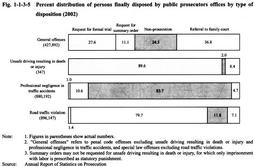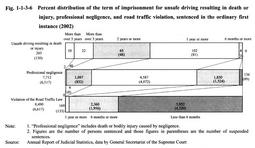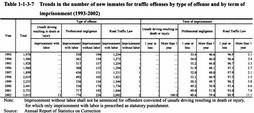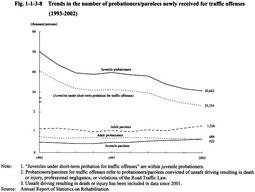| Previous Next Index Image Index Year Selection | |
|
|
2 Treatment of traffic offenders (1) Disposition by public prosecutors offices Fig. 1-1-3-5 compares the percent distribution of persons finally disposed by public prosecutors offices in 2002, for traffic offenses and non-traffic offenses (penal code offenses excluding unsafe driving resulting in death or injury and professional negligence in traffic accidents, and special law offenses excluding road traffic violations). The rates of prosecutions and of request for formal trials for professional negligence in traffic accidents were lower than those for non-traffic offenses. On the other hand, among persons referred for unsafe driving resulting in death or injury, only 2.0% were not prosecuted whereas public trials were requested for about 90% and the rest were referred to family courts. The offense of unsafe driving resulting in death or injury is applied to those traffic accidents in which offenders killed or injured people by committing heinous and dangerous driving. The data indicates that public prosecutors offices have properly handled accidents on a case-by-case basis. The rate of request for summary orders is extremely high and the rate of non-prosecution is low for road traffic violations.
Fig. 1-1-3-5 Percent distribution of persons finally disposed by public prosecutors offices by type of disposition (2002) (2) Disposition by courts Fig. 1-1-3-6 shows the percent distribution of the term of imprisonment for unsafe driving resulting in death or injury, professional negligence, and road traffic violation, in the ordinary first instance in 2002. The rate of those who were sentenced to imprisonment with or without labor but not granted suspension of execution of sentence was 36.0% for unsafe driving resulting in death or injury, 15.5% for professional negligence, and 22.1% for road traffic violations. The statutory punishment prescribed for professional negligence resulting in death or bodily injury is imprisonment with or without labor for not more than 5 years or fines of not more than 500,000 yen, whereas the statutory punishment prescribed for unsafe driving resulting in death or injury is imprisonment with labor for a limited term of not less than 1 year (in case of death) or imprisonment with labor for a limited term of not more than 10 years (in case of injury). For unsafe driving resulting in death or injury, 10 persons were sentenced to imprisonment with labor for more than 5 years in the ordinary first instance in 2002.
In 2002, for professional negligence, 205 persons were sentenced to fines in ordinary first instance and 92,823 to fines in summary proceedings. For road traffic violations, 424 persons were sentenced to fines in the ordinary first instance and 713,847 to fines in summary proceedings. Fig. 1-1-3-6 Percent distribution of the term of imprisonment for unsafe driving resulting in death or injury, professional negligence, and road traffic violation, sentenced in the ordinary first instance (2002) (3) Correction and rehabilitation of traffic offenders Table 1-1-3-7 shows the trends in the number of newly imprisoned offenders convicted of traffic offenses (unsafe driving resulting in death or injury, professional negligence, and violation of the Road Traffic Law) over the last 10 years. The newly imprisoned offenders convicted of traffic offenses began to rise in 1998, and increased by 9.5% from the previous year in 2002, 0.4% of which were for unsafe driving resulting in death or injury, 33.1% for professional negligence, and 66.5% for violation of the Road Traffic Law. By term of imprisonment, the rate of those sentenced to imprisonment for more than 1 year seems to increase recently.
Table 1-1-3-7 Trends in the number of new inmates for traffic offenses by type of offense and by term of imprisonment (1993-2002) About half of those inmates convicted of traffic offenses are detained in designated facilities nationwide, including the Ichihara Prison, where in principle, living rooms, dining halls, and workshops are not locked, and body searches are not conducted on inmates. Furthermore, no escorts are present on the prison premises, and interviews are allowed without guards whenever possible. Those traffic offenders detained in these prisons are adult inmates who are deemed suitable for open treatment and meet the following requirements: (i) they are not simultaneously serving a sentence of imprisonment with labor for any non-traffic offense; (ii) they have never been imprisoned for any non-traffic offense; (iii) the term of their sentence is about 3 months or more; and (iv) no physical or mental disorder is identified.The number of juveniles convicted of traffic offenses and sent to juvenile training schools also began to increase in 1999. In 2002, 2 juveniles were newly received for unsafe driving resulting in death or injury, 98 for professional negligence, and 705 for violations of the Road Traffic Law. On the other hand, the treatment of probationers/parolees for traffic offenses makes up a large part of the rehabilitation system in Japan. In 2002, probationers/parolees for traffic offenses accounted for 44.2% of all new probationers/parolees, and in particular, 63.0% of juvenile probationers/parolees were those for traffic offenses. Fig. 1-1-3-8 shows the trends in the number of probationers/parolees newly received for traffic offenses (unsafe driving resulting in death or injury, professional negligence or violation of the Road Traffic Law) over the last 10 years, by probation/parole type. In recent years, the adult probationers and juvenile probationers have gradually decreased while the adult parolees and juvenile parolees have been on the rise for traffic offenses (Regarding the short-term probation for traffic offenses, see Part 4, Chapter 2, Section 6 ). Fig. 1-1-3-8 Trends in the number of probationers/parolees newly received for traffic offenses(1993-2002) |



